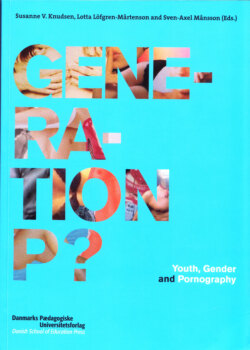Читать книгу Generation P? - Группа авторов - Страница 19
На сайте Литреса книга снята с продажи.
The world of pornography and the young consumer
ОглавлениеSexuality is, and has perhaps always been, problematic. Waves of sexual liberation are followed by the growth of new restrictions and new forms of repressive sexual morals (Dean 1996, McLaren 1999). Here we can observe a constant interplay. For instance, what seems to be an assertion of a feminist outlook on gender and sexuality, which should stand for liberation and a struggle against repression, may easily turn into a reinforcement of the phenomenon being combated and may result in a new type of moralism or in a strengthening of traditional gender roles (Dean 1996).
Studies indicate that today’s young people in Sweden show several signs of having more open attitudes toward sexuality than was the case only a decade ago. ‘One-night stands’ have become more common, and young people have more sexual partners then they did before and are younger when they have their first sexual encounter. They are also more tolerant with regard to homo- and bisexuality (Herlitz 2001). However, according to some studies, the romantic love ideology – that is, the view that love legitimizes sex – also has a strong position in young people’s sexual lives (Forsberg 2000, 2005, Frisell 1996, Helmius 1990). This ideology of “good” sexuality is not easily translated into everyday reality, however. For young people, everyday reality constitutes a kind of field of tension containing different factions and nuances, where more repressive and restrictive sexual morals represent one pole, and liberal open-mindedness the other.
One area in which more ‘traditional’ patterns of gender dualism are found is the world of pornography. And it is interesting not only to find these typical overall patterns but also to look closely at the nuances and shadings in them. The typical consumer of pornography is a young or middle-age man, but we can also find some women who enjoy pornography and quite a few men who think it is degrading (Hammarén & Johansson 2002). Studies show that young women and men often experience doubtfulness and ambivalence about manifestations of pornography and its effect on their own desires. The Swedish sociologist Lena Berg, for instance, sees certain variation in young heterosexual women’s attitudes toward pornography: some find it sexually arousing, while others experience a feeling of discomfort (Berg 1999). Berg considers that young women have learned to dislike pornography, but despite this find it difficult to check the various effects such content may have on them. Also young men experience this ambivalence between arousal, excitement, disgust and shame (Sørensen & Knudsen 2006; Hammarén & Johansson 2002, Johansson & Hammarén 2007). This ambivalence must be related to constructions of masculinity within a society struggling for gender equality (Hammarén & Johansson 2002, Johansson 2007).
Accordingly, we cannot understand young people’s reactions to pornographic material outside the context of a specific society where certain normative views and controls on sexuality prevail (Foucault 1976). It may be difficult to admit that one is sexually aroused by something one also takes exception to. Similarly, acceptance of a certain type of sexual expression may be viewed as manly. And although many young people take exception to pornographic images of sexuality and gender, we also live in a society marked by individualism and a liberal ideology. The notion that people should be able to choose to consume pornography if they wish is strong. Thus, discourses of individualism, liberalism, equality and traditional gender patterns give rise to a multiplicity of ideas about sexuality.
The fact that people are currently being deluged with sexual pictures and narratives – that ‘the clinical gaze’ has become an everyday starting point for formulating views and politics concerning sexuality – and that this does not keep them from acknowledging their sexuality and enjoying sex and their bodies, renders analysis of these phenomena considerably more complicated. Here, we are entering a field whose length and breadth have been travelled by early pioneers and explorers who have mapped and studied human sexuality and who have said both intelligent and extremely simplistic things about it. In the midst of this crossfire, we are trying to discover something to say something about this field of intimacy, closeness and physicality. But what is there left to be said? Has everything important already been expressed?
Perhaps people tell stories only within the framework of what is socially desirable or acceptable and hide alternative discourses, thus giving a skewed picture of human sexuality. Does there still exist, then, a normative sexuality, a kind of hegemonic ditto? Or do we instead observe an enormous differentiation – a landscape of sexual freedom? For young people today, everyday reality constitutes a kind of field of tension containing different factions, where more repressive and restrictive sexual morality represent one extreme position and liberal open-mindedness another (Hammarén & Johansson 2002). In Freud’s time, this was a question of neuroses and of the repression of sexuality. The perverse, polymorphic individual emerged as the other side of neurosis and repression. This was a person who acknowledged all aspects of his/her sexuality and body, an individual who had not subordinated these things to the genitals or to the paradigm of reproduction. Today’s pornographer is yesterday’s polymorphic individual, which brings to the fore the transformations of the discourses and their impact on categorizations and identities.
According to Foucault, science – not least sexology – has helped to create new combinations of power, physicality and sexuality. Scientific classifications are transformed into ‘truths’. In some cases, this has led to strong opposition to an excessively narrow way of looking at sexuality, in other cases (homosexuals, for example), to people’s use of scientific categories and tools in the active formation of their own sexuality. Thus, modern forms of sexuality are largely products of science, which implies the disappearance of our ability to speak of any form of pure or authentic sexuality.
